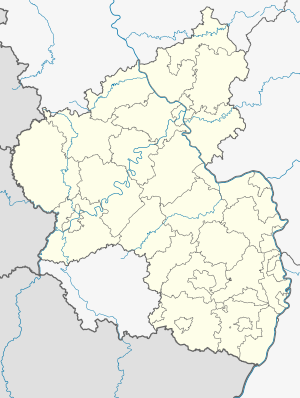Lichtensteiner head tunnel
| Lichtensteiner head tunnel | ||
|---|---|---|
| use | Railway tunnel | |
| traffic connection | Mannheim – Saarbrücken railway , Palatinate Ludwig Railway | |
| place | Neidenfels | |
| length | 92 m | |
| Number of tubes | 1 | |
| construction | ||
| Client | Palatine Ludwig Railway Company | |
| start of building | 1845 | |
| business | ||
| operator | Deutsche Bahn | |
| release | August 25, 1849 | |
| location | ||
|
|
||
| Coordinates | ||
| North portal | 49 ° 23 '29 " N , 8 ° 2' 25" E | |
| South portal | 49 ° 23 ′ 27 " N , 8 ° 2 ′ 28" E | |
The Lichtenstein head tunnel is one of a total of twelve tunnels on the Mannheim – Saarbrücken railway line that emerged from the Palatinate Ludwigsbahn and, at 92 meters, is the third shortest after the Eisenkehl and Franzosenwoog tunnels .
location
The tunnel is located in the district of the local community Neidenfels not far from the north-western edge of the settlement. It is used to shorten a loop of the Hochspeyerbach to cross under a foothill of the eponymous Lichtensteiner Kopf . The ruins of Lichtenstein Castle are in the immediate vicinity of the tunnel . Both in front of the north and in front of the south portal, this and the federal highway 39 running parallel to it are crossed by a bridge. Not far from the bridge structure at the south portal is the siding of a company for fine paper.
history
On December 21, 1837, the Bavarian King Ludwig I gave the green light to the construction of a main line in an east-west direction from the Rheinschanze to Bexbach . Between Neustadt and Frankenstein numerous hills and foothills had to be overcome for the ascent. Among them was the Lichtensteiner Berg , from which two foothills opposed the planned route like a wedge. One of them was not far from Lichtenstein Castle. This required the construction of a 92-meter-long tunnel in this area. Traffic from Ludwigshafen to Neustadt had already been opened in 1847, and in 1848 the Homburg – Frankenstein section followed in two stages . On August 25, 1849, the gap between Frankenstein and Neustadt including the Lichtenstein head tunnel followed. Carriages had previously taken over the traffic between the two sections of the route. In July 1856, the Ludwig Railway was then consistently double-tracked.
Since the main line from Mannheim to Saarbrücken has always been of great importance for long-distance traffic, it was gradually electrified from 1960. The Lichtenstein head tunnel had to be widened for electrification. This delayed the completion of the electrical operation, which could finally be started on March 12, 1964 on the entire length.
literature
- Heinz Sturm: The Palatinate Railways (= publications of the Palatinate Society for the Advancement of Science. Volume 53). New edition. pro MESSAGE, Ludwigshafen am Rhein 2005, ISBN 3-934845-26-6 .
Individual evidence
- ^ Eisenbahn-tunnelportale.de: Line 3280: Lichtensteiner Kopf-Tunnel . Retrieved November 21, 2013 .
- ↑ Heinz Sturm: The Palatinate Railways . 2005, p. 53 .
- ↑ Heinz Sturm: The Palatinate Railways . 2005, p. 96 .
- ↑ Heinz Sturm: The Palatinate Railways . 2005, p. 113 ff .
- ↑ Heinz Sturm: The Palatinate Railways . 2005, p. 146 .
- ↑ Fritz Engbarth: From the Ludwig Railway to the Integral Timed Timetable - 160 Years of the Railway in the Palatinate . 2007, p. 23 f .
